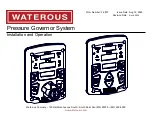
2
Service Manual
CAUTIONS (Continued)
• BD supplies temperature simulators (fixed value
resistors) for testing, training and demonstration
purposes. Never use this device, or other method, to
circumvent the normal patient temperature feedback
control when the system is connected to the patient.
Doing so exposes the patient to the hazards associated
with severe hypo- or hyperthermia.
• It is recommended to measure patient temperature
from a second site to verify patient temperature. BD
recommends the use of a second patient temperature
probe connected to Arctic Sun™ Temperature
Management System Temp In 2 input as it provides
continuous monitoring and safety alarm features.
Alternatively, patient temperature may be verified
periodically with independent instrumentation.
• The displayed temperature graph is for general
information purposes only and is not intended to
replace standard medical record documentation for use
in therapy decisions.
• Patient temperature will not be controlled and alarms
are not enabled in Stop Mode. Patient temperature may
increase or decrease with the Arctic Sun™ Temperature
Management System in Stop Mode.
• Carefully observe the system for air leaks before and
during use. If the pads fail to prime or a significant
continuous air leak is observed in the pad return line,
check connections. If needed, replace the leaking pad.
Leakage may result in lower flow rates and potentially
decrease the performance of the system.
• The Arctic Sun™ Temperature Management System is
for use only with the ArcticGel™ pads.
• The ArcticGel™ pads are only for use with the Arctic
Sun™ Temperature Management System.
• The ArcticGel™ pads are non-sterile for single patient
use. Do not reprocess or sterilize. If used in a sterile
environment, pads should be placed according to
the physician’s request, either prior to the sterile
preparation or sterile draping. ArcticGel™ pads should
not be placed on a sterile field.
• Use pads immediately after opening. Do not store pads
once the kit has been opened.
• Do not place ArcticGel™ pads on skin that has signs of
ulceration, burns, hives, or rash.
• While there are no known allergies to hydrogel
materials, caution should be exercised with any patient
who has a history of skin allergies or sensitivities.
• Do not allow circulating water to contaminate a sterile
field when patient lines are disconnected.
• The water content of the hydrogel affects the pad’s
adhesion to the skin and conductivity, and therefore,
the efficiency of controlling patient temperature.
Periodically check that pads remain moist and
adherent. Replace pads when the hydrogel no longer
uniformly adheres to the skin. Replacing pads at least
every 5 days is recommended.
• Do not puncture the ArcticGel™ pads with sharp objects.
Punctures will result in air entering the fluid pathway
and may reduce performance.
• If accessible, examine the patient’s skin under the
ArcticGel™ pads often, especially those at higher risk of
skin injury. Skin injury may occur as a cumulative result
of pressure, time and temperature. Possible skin injuries
include bruising, tearing, skin ulcerations, blistering,
and necrosis. Do not place bean bag or other firm
positioning devices under the ArcticGel™ pads. Do not
place positioning devices under the pad manifolds or
patient lines.
• Due to underlying medical or physiological conditions,
some patients are more susceptible to skin damage from
pressure and heat or cold. Patients at risk include those
with poor tissue perfusion or poor skin integrity due to
diabetes, peripheral vascular disease, poor nutritional
status, steroid use or high dose vasopressor therapy. If
warranted, use pressure relieving or pressure reducing
devices under the patient to protect from skin injury.
• The rate of temperature change and potentially the
final achievable patient temperature is affected by
many factors. Treatment application, monitoring and
results are the responsibility of the attending physician.
If the patient does not reach target temperature in
a reasonable time or the patient is not able to be
maintained at the target temperature, the skin may
be exposed to low or high water temperatures for an
extended period of time which may increase the risk
for skin injury. Ensure that pad sizing/ coverage and
custom parameter settings are correct for the patient
and treatment goals, and the patient temperature
probe is in the correct place. For patient cooling, ensure
environmental factors such as excessively hot rooms,
heat lamps, and heated nebulizers are eliminated and
patient shivering is controlled. Otherwise, consider
increasing minimum water temperature, modifying
target temperature to an attainable setting or
discontinuing treatment. For patient warming, consider
decreasing maximum water temperature, modifying
target temperature to an attainable setting or
discontinuing treatment.
• Do not allow urine, antibacterial solutions or other
agents to pool underneath the ArcticGel™ pads. Urine
and antibacterial agents can absorb into the pad
hydrogel and cause chemical injury and loss of pad
adhesion. Replace pads immediately if these fluids
come into contact with the hydrogel.
• Do not place ArcticGel™ pads over an electrosurgical
grounding pad. The combination of heat sources may
result in thermal injury.
• If needed, place defibrillation pads between the
ArcticGel™ pads and the patient’s skin.
• Carefully remove ArcticGel™ pads from the patient’s
skin at the completion of use. Discard used ArcticGel™
pads in accordance with hospital procedures for medical
waste.
• The USB data port is to be used only with a standalone
USB flash drive. Do not connect to another mains
powered device during patient treatment.
• Users should not use cleaning or decontamination
methods different from those recommended by
the manufacturer without first checking with the
manufacturer that the proposed methods will not
damage the equipment. Do not use bleach (sodium
hypochlorite) as it may damage the system.






































